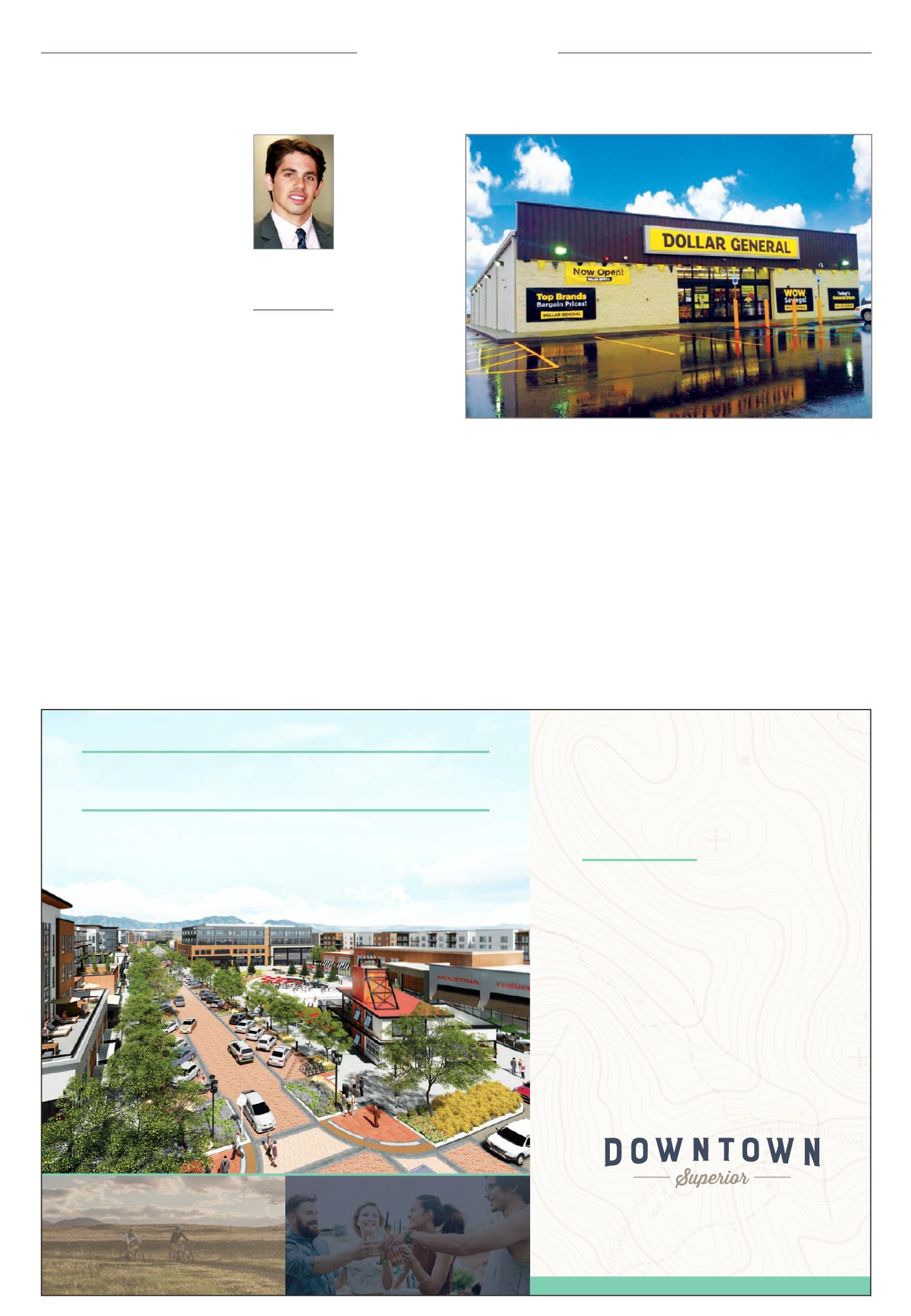

Page 6
— Retail Properties Quarterly — November 2017
www.crej.comBIG OPPORTUNITIES ARE AVAILABLE
IN DOWNTOWN SUPERIOR.
Just outside Boulder and a short commute from Denver,
a vibrant, new Downtown Superior is taking shape. This
urban hub offers land for office and mixed-use residential/
retail, plus new office and retail space built to suit. The
area offers competitive economics, easy access to Denver
International Airport, an educated employment pool and
a sought-after location. It will be an energetic, eclectic
mix of retail, shopping, dining, entertainment and living—
walkable, sustainable and surrounded by acres of gorgeous
Colorado open space.
Fully entitled for up to 817,600 square feet of office,
retail and restaurant space; 1,400 residential units;
and 500 hotel rooms.
Visi
t DowntownSuperior.comFRESH OPPORTUNITIES FOR BUSINESS,
RESTAURANTS, RETAIL AND MORE.
That’s a
Superior idea.
R
eal estate investors and 1031
exchange buyers continue to
gravitate toward single-tenant
net lease properties as these
properties typically offer long-
term leases, minimal management
responsibilities and credit tenants.
However, the supply of new construc-
tion single-tenant properties with
long-term leases continues to dimin-
ish.With many consumers abandon-
ing brick-and-mortar retail in favor of
e-commerce, numerous retailers have
significantly reduced or halted their
expansion plans. This has resulted in
a lack of supply of new construction
long-term, single-tenant properties.
Few retailers are expanding at the
pace of dollar stores. Dollar General is
expected to open 1,000 stores in 2017
while Dollar Tree/Family Dollar plans
to open 650 stores. Needless to say,
dollar stores are expanding at a fero-
cious pace – and for good reason.
In 2016, Dollar General grew its
same-store sales by 0.9 percent,
which represented the 27th consecu-
tive year of same-store sales growth.
Meanwhile, Dollar Tree, which is the
parent company of Family Dollar, saw
its same-store sales grow by 1.8 per-
cent, which accounted for its ninth
consecutive year of same-store sales
growth. Both retailers continue to
grow their same-store sales despite
significant new store expansion,
increasing prevalence of e-commerce
and the Great Recession of the late
2000s. Dollar stores have been careful
to expand rapidly while not cannibal-
izing existing locations. Their busi-
ness model has proven to be largely
e-commerce resistant as a majority
of their consumers are located in sec-
ondary markets that
make e-commerce
cost-prohibitive and
inefficient. Lastly,
dollar stores are
resilient in difficult
economic times as
their products are
convenience goods
offered at an afford-
able cost.
Dollar General and
Family Dollar sell
name-brand prod-
ucts that frequently
are used and replenished, such as
food, snacks, health and beauty aids,
as well as cleaning supplies, family
apparel, housewares and seasonal
items. The products typically range in
price from $1 to $10. The Dollar Tree
business model is slightly different as
it sells snacks, food, candy, health and
beauty products, toys, gifts, party sup-
plies, stationery, craft supplies, teach-
ing supplies, books, seasonal décor,
glassware, dinnerware and cleaning
supplies for $1 per item or less.
Dollar General, Family Dollar and
Dollar Tree offer real estate investors
favorable lease terms. A new construc-
tion property offers an initial lease
term of seven to 15 years with up to 30
years of renewal options and minimal
to no landlord responsibilities.
Helping fuel the rapid growth of the
dollar store sector are the preferred
developers, some of which are build-
ing more than 25 stores per year.
Because the developers have such
large pipelines of properties under
construction, they typically sell a
significant amount of their product
to either allocate capital into future
development or take a profit. Since the
start of 2016, there have been over 510
new-construction dollar stores sold
nationally, according to CoStar. Previ-
ously, institutional buyers and invest-
ment funds acquired large portfolios
of new-construction dollar stores but
have since limited their acquisition of
this sector as they fulfilled their allot-
ment.
Where in the past the developers
could rely on an institutional buyer
or investment fund to acquire the
pipeline of stores, developers now are
selling the new stores in small portfo-
lios or one-off transactions to private
capital buyers. This has resulted in a
significant increase in the supply of
new-construction dollar stores on the
market and capitalization rates that
have risen slightly year over year. Cap
rates for new-construction dollar store
properties typically are between 6 and
7 percent, which is priced at a slight
discount to the single-tenant retail
market as a whole. The discount asso-
ciated with dollar store properties can
be attributed to their location, which
typically is in a secondary market.
Older dollar store properties with
less than 10 years of lease term
remaining also garner significant
investor interest as the properties
typically offer a higher return. These
Why dollar stores are the retailers of the futureMarket Update
Zach Wright
Investment sales
broker, Pinnacle
Real Estate
Advisors, Denver
Dollar stores continue to grow their same-store sales despite significant new store expan-
sion, increasing prevalence of e-commerce and the Great Recession of the late 2000s.
Please see Wright, Page 26















